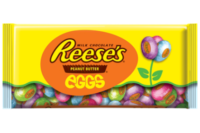Sparking Seasonal
Confectionery Sales
By Paul Waldron,
Gladson Interactive
Gladson Interactive
Selling more seasonal candy requires more of a
merchandising commitment in the store.
Retailers have done a good job bringing shoppers to the traditional candy aisles. It is time now, many experts agree, to refocus on seasonal categories. The trend to get shoppers into the department more often has been accomplished by moves such as these.
Retail theater, which ranges from artfully
decorated display shippers to interactive display components such as
having a train run across the ceiling in a section of the store
New merchandising twists such as merchandising
by snacking occasion; lunchbox snacks or movie-time favorites are just two
examples
More co-branded and licensed candies
Larger assortments of sugar-free or healthful
candies — primarily in the non-chocolate category
Innovative new items, especially those in
convenient packages With shoppers trained to look for candy at their
favorite store, retailers can capitalize on that everyday traffic to ignite
seasonal sales. A well-stocked day-in and day-out department can help
customers remember your store when it is time for a seasonal destination
purchase. And clever seasonal displays will stimulate impulse sales.
“In candy, you really need to customers to buy
just one more item to make a big difference on the bottom line,” says
Wendy Liebmann, president and founder of WSL Strategic Retail.
2006 promises to be a good year for seasonal candy
sales, according to Jim Corcoran, vice president of trade relations for the
National Confectioners Association. The calendar is working in favor of the
industry, he notes, adding that NCA is predicting low single-digit growth
for seasonal confectionery sales for the year. That theory already held
true for Valentine’s Day, which fell on a Tuesday. Chocolate sales
rose 1.3 percent to $769 million, according to Information Resources Inc.
data.
Sweets for your sweet
Valentine’s Day 2006 provided a good example of
how to put pizzazz into the holidays. Both candy companies and retailers
worked in tandem to feature more high-end selections this year. The result
was that sales rose even though fewer units were moved. Several chains
merchandised small candy items near kids’ Valentine’s Cards so
shoppers could include a sweet with the note. Hershey’s was singled
out by retailers as offering some especially clever Valentine’s
products, including the new Kissables. Although not a seasonal item, the
new candy-covered mini chocolate kisses certainly fit nicely into
Valentine’s Day themes. A focus on premium candies at mass also
helped Dove and Cadbury chocolate candy enjoy double-digit sales gains of
52 percent and 31 percent, respectively. Floorstands in floral, cosmetics,
books and greeting cards departments helped some chains move more
Valentine’s Day candies.
The Easter Bunny cometh
The relatively late date of Easter this year (in the
same week as Passover) helped create strong demand for Easter candy.
Although sales had not been reported at press time, several retailers
estimated their sales were up over last year’s soft period. One
program that helped crack open Easter sales was a new color-coded shelf
header system that organized candy by shopping activity. Retailers hope to
expand that concept for 2007.
For those retailers offering kosher confections, the
season was fruitful. Some chains carved out an entire Passover department.
Halloween stands on its own
Halloween is less likely than Valentine’s Day to
be affected by the day of the week on which it falls. The biggest boost to
sales has come in the growth of treat size package and mini-size bars. Data
suggests that more than half of all snack-size candy sold at Halloween was
specifically for trick or treaters vs. personal snacking. Halloween remains
the biggest seasonal candy selling opportunity, so it’s critical for
retailers to take steps to ensure that their store is the consumer’s
Halloween shopping headquarters.
Research from The Hershey Company presented to
retailers in business review meetings shows the accounts that do best are
those that are most aggressive with signage, point of sale materials and
decorations. Although Halloween is undeniably a big time for seasonal candy
sales, chocolate sales rose only 0.4 percent last year and sales of
non-chocolate products declined slightly. Retailers at chains including
Brooks Drug, Walgreens, CVS and Wegmans say they plan to put more effort
into Halloween 2007, especially with candy products aimed at adults and
adult parties.
Holiday predictions
Shoppers are burdened with many bills — not to
mention the skyrocketing price of gasoline, so clearly the pressure is on
candy companies and retailers seeking to grab their fair share of
consumers’ disposable income. To achieve that objective, make candy
an escape they can’t resist and offer a smattering of
“affordable luxury” goods, marketing pros recommend. With a
season, shoppers may figure they have an extra reason to celebrate.
Convenience stores are showing the fastest growth in
overall candy sales, according to Information Resources Inc. Other channels
need to do more to make the trip quick and easy, Liebmann suggests.
Last Christmas was “okay” for most
merchants with IRI reporting a 4.2 percent sales gain for chocolates, but a
drop of 2.9 percent in non-chocolates. Although consumers lament the
early appearance of holiday merchandise, they still bought early —
especially in candy. A survey of 15 drug store and food chains found that
almost 50 percent of December holiday candy was sold two weeks before the
day of the holiday. In comparison, half of fragrances are often sold in the
last few days before the holiday, buyers said. Finally, experts point out
that the winter holiday season can be stretched with winter images rather
than specific Christmas or Hanukkah symbols on packaging and displays.

